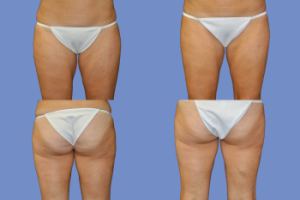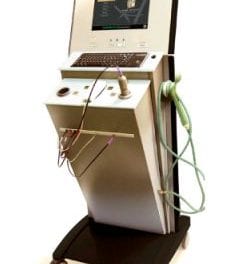
Figure 1. Female, nulliparous, mid 30s. Six Zerona cold laser treatments; 11.43 cm dimensional loss and 2.05 Kg weight loss.

Figure 2. Female, late 30s, postpartum. Twelve Zerona cold laser treatments; 5.7 cm dimensional loss at waist.

Figure 3. Male mid 30s.

Figure 4. Female, mid 20s. Laser-assisted liposculpture of the neck; 2 weeks postop.

Figure 5. Female, mid 30s, received a “mommy makeover” treatment; SmartLipo liposculpture with abdominoplasty.

Figure 6. Female, nulliparous, late 20s.

Figure 7. Female, nulliparous, early 20s. The image at right is 2.5 years postsurgery.
Fat management is one of the biggest challenges in cosmetic surgery. Our patients have excesses, deficiencies, maldistribution, irregularities, ptosis, and asymmetry. Our challenge is to manage this while focusing on the optimal aesthetic outcome. This includes removal and rearrangement, along with simultaneous addressing of skin and fascial laxity, asymmetries, and irregularities, including cellulite.
Theoretically, our patients could follow a diet and exercise regimen and achieve their goals via nonsurgical means. Unfortunately, this has been an overall failure. Obesity rates have risen, and fitness levels have declined. Also, gender-specific aging changes occur, influencing body fat distribution with the appearance of cellulite, dimpling, and skin and fascial laxity.
I take a customized approach to these problems, including the following:
- Address fitness and exercise levels;
- Dietary counseling and patient self-management;
- Nonsurgical, noninvasive cold laser technology;
- Standard liposculpture;
- Laser-assisted liposculpture;
- Lipo-harvest and transfer;
- The use of external radiofrequency energy; and,
- Surgery.
The choice is determined after the patient consultation with an informed review of their goals, time constraints, expectations, and financial commitment.
Body mass index (BMI) is always reviewed and discussed. Diet and exercise are reviewed, and dietary and medical consultation is made available.
THE NONINVASIVE COLD LASER
The typical patient requesting this procedure is of average to slightly above ideal body weight, with a BMI less than 30 (and preferable 25 or less).
They often state that they do not want surgery, preferring a noninvasive alternative. They can usually identify problem areas, such as the waist or hips, and wish to have clothing fit better.
I use the Zerona cold Erchonia laser for treatment. Typical treatments are 40 minutes each, with nine treatments over 2 to 3 weeks. With commitment to protocols, these patients lose inches and their clothes fit better.
Interestingly, although weight loss is not a goal, the average patient that I treat loses 4 pounds and two clothing sizes. Most patients lose one size within four to five treatments and continue with loss.
Some patients request treatment using the cold laser, but after consultation are revealed to be better candidates for liposculpture and fat removal.
LASER-ASSISTED LIPOSCULPTURE
These patients are usually of ideal body weight or overweight, with a body mass index of 30 or less. They often have specific areas of concern and frequently complain of loose skin.
Men in this group usually seek treatment of the flanks and abdomen. Many also have gynecomastia. In contrast, women often request treatment of the abdomen, flank, bra region, upper lateral chest, upper arms, saddle bags, inner thighs, and knees.
My current preferred technique includes laser-assisted liposculpture with the dual-wave 1064/1320 Cynosure MPX Smart Lipo laser. Tumescent liposculpture is used in all cases with removal of the effluent together with necessary fat. Following the application of laser energy, microcannulas are used.
MALE COSMETIC SURGERY
Usually, men want the abdomen and flanks treated. They tell me that they would like increased muscle definition.
These patients are marked differently from standard patients. Markings are made along the muscle fiber direction highlighting increased definition in specific vectors aligning with muscle directional movement.
Where I am aiming for maximum muscle definition, I place instruments directly over the muscle fascia with many low-energy laser passes, followed by cannula passes once fat has been liquefied by the laser.
Thermal studies at our center using clinical rather than temperature end points confirm a significant reduction in dimension—as well as weight—in males at 7 months postop. These men wear a postoperative compression garment for 2 to 6 weeks. It usually takes several weeks before increased definition is observed. This gradually increases as healing progresses and reaches a stable end point by 7 months.
The longest follow-up has been 2.5 years with continued improvement past the seventh postop month.
Many men also have gynecomastia along with lipodysmorphia of the abdomen and flanks. All three areas are treated at the same session.
Laser-assisted liposculpture is used for the breast reduction.
Where there is significant fibrous residual breast tissue, some require a half-moon inferior periareolar incision and excision of the residual breast tissue along with liposculpture. Where breast tissue is encountered, it is submitted for pathological examination. Postoperatively, a compression vest is used for 6 weeks.
MOMMY MAKEOVERS
Women often request treatments of the “mommy makeover” type. They present additional problems of striae distensae, skin and fascial laxity, and rectus abdominus dehiscence. They rarely request maximum definition. Those who request increased definition are usually nulliparous younger women.
The abdominal region usually requires the most discussion—most women tell me that they prefer improvement with some skin shrinkage. Many tell me that they do not want an abdominoplasty. For some, with lipodysmorphia and good skin-fascial quality, this provides a result that they approve.
For others with poor skin quality, striae distensae, or rectus muscle dehiscence, abdominoplasty is a better choice.
In carefully selected cases, liposculpture of other areas of lipodysmorphia is done at the same surgical session as the abdominoplasty. This depends on the extent and difficulty of the procedures anticipated, as well as the patient’s health.
Preference is given to laser-assisted liposculpture if skin-fascial laxity is an issue and when larger volumes will be removed in younger women. In some, where larger volumes of fat are to be removed, power-assisted liposculpture is used.
EVIDENCE-BASED TREATMENT

Figure 8. Male mid 30s.

Figure 9. Male late 20s.
Laser lipolysis is my current preferred method of liposculpture, due to the combination of ease of use and postoperative skin shrinkage.
Some authors have used a thermal end point for treatment. Thermal studies at the Michigan Center for Cosmetic Surgery using the dual-wave 1064/1320 SmartLipo MPX laser for lipolysis on men using clinical rather than temperature end points have documented a significant reduction in dimension—as well as weight—in males at 7 months postop.
This research has been submitted for publication. Additional studies are being conducted on women using the same protocol.
Based in Ann Arbor, Mich, Robert H. Burke, MD, FACS, is director of the Michigan Center for Cosmetic Surgery; Adjunct Clinical Professor, Maxillofacial Surgery at the University of Michigan; Clinical Professor of Surgery at Michigan State University; and a trustee of the American Academy of Cosmetic Surgery. He can be reached at (734) 971-0262 or www.robertburke.com.




